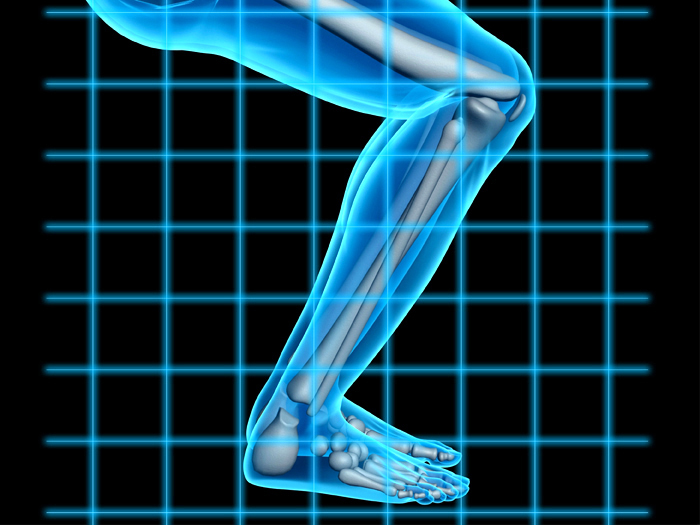Is It Ever Okay for Your Knees to Extend Beyond Your Toes?
The answer might surprise you—and make your squats and lunges much more comfortable.

Walk upstairs, bend down to tie your shoe, or sit down on the toilet.
What do these everyday movements have in common? They all involve your knees going forward past your toes. And as you’ve likely heard, that’s a major no-no in the exercise world. But is it really that bad?
The short answer: No.
“I think this myth is just like any in the fitness industry,” says Gavin McHale, a certified exercise physiologist based in Winnepeg. “Someone gets ahold of it and blows it out of proportion.”
Here’s what to know to keep your knees—and your whole body—safe.
How Squats, Lunges, and Everyday Movement Affect Your Knees
What is true: If your knees track forward farther than your toes when you’re in a squat or lunge position, it increases the stress placed on the injury-prone knee joints. However, the increase isn’t as big as some people might lead you to believe.
In one study from the University of Memphis, researchers had people perform weighted squats two ways:
- Unrestricted, allowing their knees to move forward past their toes
- Restricted, with a wooden barrier in front of the knees to prevent them from moving forward past the toes
What happened? When the knee was allowed to move forward, it experienced a 28 percent increase in stress.
But the study also found restricting forward knee movement increased stress on the hips by almost 1,000 percent! It also added stress on the lower back. So while restricting forward movement of the knees may minimize stress on them, it’s likely that forces are inappropriately transferred to the hips and lower back.
That’s bad for many reasons, but particularly because musculoskeletal pain affects 65 to 85 percent of older adults, with lower back pain being the primary complaint leading to mobility and functional limitations, according to a 2018 review.
Plus, it’s important to think back to those day-to-day activities, like sitting down and getting up from the toilet. It’s simply a natural lower-body motion for the knees to move forward past the toes when you do that. And to stay strong in everyday life, your workout routine needs to involve functional, real-life movement patterns, says Tony Gentilcore, C.S.C.S., founder of CORE training studio in Boston.
That may include squatting to a position in which the knees go slightly over the toes. And if you are performing stepups—which are great for your glutes and helping you tackle stairs—your knee is pretty much guaranteed to go past your toes, he says.
A Better Exercise Cue for Healthy Knees
“To say across the board that the knees should never pass the toes is absurd,” McHale says. “But that doesn’t mean the knee shouldn’t be monitored.”
Here’s a more helpful cue: When performing squats, lunges, and stepups, focus on keeping your weight in the heel and mid-foot. This will ensure that if and when your knees do move slightly forward, the weight of your body won’t get dumped into them.
In addition to protecting your knees, this cue trains total-body balance and stability. Both in and out of the gym, moving your weight forward into the balls of your feet or toes and allowing your heels to raise can throw off balance and increase risk of falls. By keeping your weight centered or slightly back, you’ll be more solid on your feet.
Find the Right Exercises for You
If you have a chronic condition, balance issues, or injuries, start by talking to your doctor about how you can exercise safely. A physical therapist or fitness professional can also help evaluate your specific needs and recommend the best exercises for your knees. And if you’re taking a SilverSneakers class, let the instructor know about any knee issues.
When exercising, pay attention to how your knees respond, and stop what you’re doing if you experience joint pain. Luckily, there are countless ways to perform any given exercise, and there’s no reason to force your body into painful movements. Try these modifications.
Subscribe to our newsletter
It's quick and easy. You could be one of the 13 million people who are eligible.
Already a member? Click to discover our 15,000+ participating locations.
Follow Us
Make squats easier: If a bodyweight squat is too challenging for any reason—strength, pain, or mobility issues—start from a seated position. Simply sit down, and plant your feet on the floor. From there, keep your chest up, knees out, and push down through the ground to stand up. Lower back down to sit in the chair.
If you have a knee issue that hurts when you squat, start from a seated position and push up just a couple inches. Once you feel some tension, release to sit back down. Even with this small range of motion, you’ll still build strength in your legs, hips, and core.
See more tips for your best squat.
Make lunges easier: Widen your stance by starting your lunges with your back foot farther away from your front foot than you normally would. You’ll automatically find that you aren’t getting bunched up and compromising your form.
Finding your ideal setup might require some trial and error. Perform a few reps, and if you still feel pain or discomfort in your knee, step your back foot a little farther behind you.
See more ways to make lunges easier on your knees.
Check Your SilverSneakers Eligibility Instantly
SilverSneakers gives you free, unlimited access to more than 15,000 gyms and fitness centers across the nation, plus classes and tools designed to keep older adults strong and independent. Check your eligibility instantly here.
Already a member? Get your SilverSneakers member ID and exclusive content by logging in to or creating your online account here.





